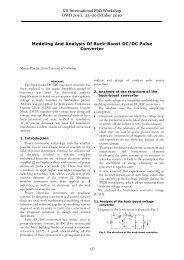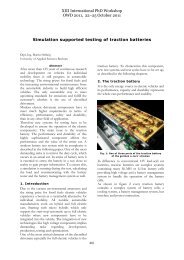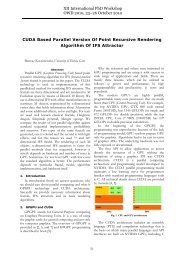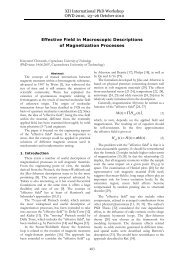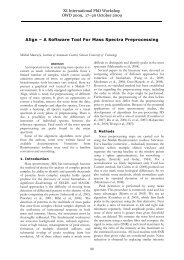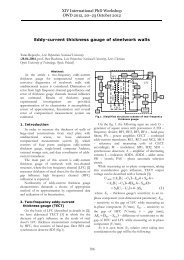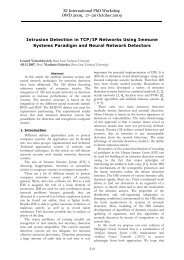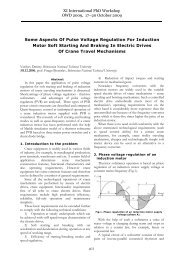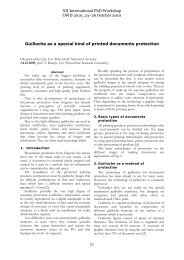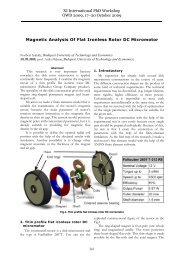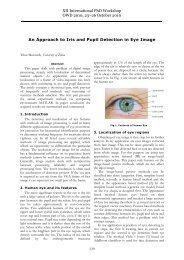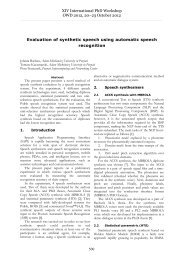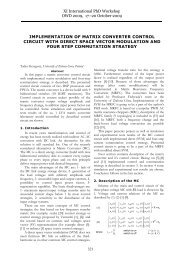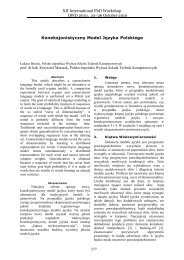Low Cost Inkjet printing System For Organic Electronic
Low Cost Inkjet printing System For Organic Electronic
Low Cost Inkjet printing System For Organic Electronic
You also want an ePaper? Increase the reach of your titles
YUMPU automatically turns print PDFs into web optimized ePapers that Google loves.
1. The design of <strong>Inkjet</strong> printer<br />
In this paper the design of piezoelectric print head<br />
based inkjet printer is described. It has been designed<br />
and built in Tele & Radio Research Institute (ITR). It<br />
is a small and low cost inkjet printer. The issue was to<br />
design flexible, low cost <strong>printing</strong> system to support<br />
material science investigation, technology optimization<br />
and new technology development. New <strong>printing</strong><br />
system should have <strong>printing</strong> abilities no lower than<br />
commercial printers and low cost couldn’t be an<br />
excuse. Commercial available <strong>printing</strong> systems has<br />
already been found inaccurate for some task realized<br />
in R&D units or in small laboratories. Those<br />
disadvantages, commonly described by the users were<br />
supposed to be removed from new designed <strong>printing</strong><br />
system. Built <strong>printing</strong> system, is based on MicroDrop,<br />
piezoceramic PZT print head system [9]. This specific<br />
system gives the highest spectrum of compatible inks.<br />
It is possible to use inks with pH in the range 1-12,<br />
viscosity 1-12 cPs. Nozzle diameters in this printer are<br />
50 µm and 100 µm, drop volume is in range from 35<br />
pl to 85 pl. Printhead has a heater, build in, that<br />
allows to heat up ink inside of the nozzle up to 100˚C.<br />
Printhead is controlled by attached driver unit.<br />
Generated electric pulse deforms piezoelectric<br />
actuator inside of the printhead. Operator controls the<br />
right pulse shape to get single “drop on demand”<br />
(DoD). Amplitude, length and delay of the pulse can<br />
be also set according to optimize drop shape.<br />
Amplitude can be set in range 0-250 V, length from 10<br />
– 300 ms, and delay from 1000 to 9999 µs. Control<br />
unit generates strobe signal for the strobe light. This<br />
gives the ability to observe drops in still – “frozen”<br />
position using simple CCD camera. This system is also<br />
called “Drop Watcher”. Delay of the strobe light<br />
signal can be adjust to freeze the right moment of the<br />
drop forming process. Commercial drop watch<br />
systems does not allow to freeze the picture<br />
Therefore, adjusting and optimization is less accurate<br />
then. Drop forming sequence taken by the strobe light<br />
CCD camera in different time delays is shown in Fig.<br />
1.<br />
Fig. 1. Drop forming sequence of PEDOT:PSS taken by<br />
the CCD camera. Time offset was 20µs, 30µs, 40µs.<br />
206<br />
2. Printing tests<br />
Printer abilities has been tested by <strong>printing</strong> patterns<br />
on most use substrates and by using variety of inks. To<br />
test precision and accuracy specific pattern was<br />
designs. An array of single dots, dot lines, horizontal<br />
and vertical. <strong>For</strong> system tests nano silver based ink was<br />
used, this ink is a commercial ink provide by<br />
Amepox[14]. Dot spacing was 0,15 mm, dot diameter<br />
100 µm. Printhead impulse was set to 110 V and 50<br />
µs. Substrate temperature was 65 ˚C. As a substrate<br />
glass was used. 10 exact patterns has been printed.<br />
Specimen were measured by using optical microscopy<br />
(see fig. 4). Diameter, spacing and position of each dot<br />
was measured and analyzed. Dots diameter was 100<br />
µm ± 4 µm, horizontal spacing 150 µm ± 2 µm,<br />
vertical spacing 150 µm ± 4 µm, position error 5 µm<br />
(as a distance from theoretic position to printed dot<br />
center), shape error 11 µm (as o standard deviations<br />
from ideal round shape).(Fig.2.)<br />
Fig. 2. Printed test pattern and shape precision.<br />
Shape precision and jetting accuracy was also<br />
investigated. As a substrate for this test, glass was<br />
used. Single drop was jetted one more time on the<br />
printed pattern. As it can be seen, dots from the<br />
second layer are deposited precise on centers of first<br />
layers dots. This proves very high <strong>printing</strong> precision.<br />
Second layer dots exhibit smaller shape error, less than<br />
3µm from model circular shape. However second layer<br />
dots have smaller diameter, the average diameter is 92<br />
µm. This is caused by different surface tension on<br />
clean substrate surface and printed dots surface.<br />
3. Line <strong>printing</strong> investigation<br />
Line <strong>printing</strong> ability was investigated. Using built<br />
<strong>printing</strong> system conductive lines were printed on<br />
ceramic substrate. As ink, nano silver based ink was<br />
used. Line <strong>printing</strong> tests were divided into four<br />
categories by quantity of layers. Lines were printed on<br />
substrate heated to four temperatures, 40°C, 60°C,<br />
80°C, 100°C. The issue was to find optimal parameters<br />
for <strong>printing</strong> conductive lines using nano silver based<br />
ink. Results of this test can be seen in tab. 1.



